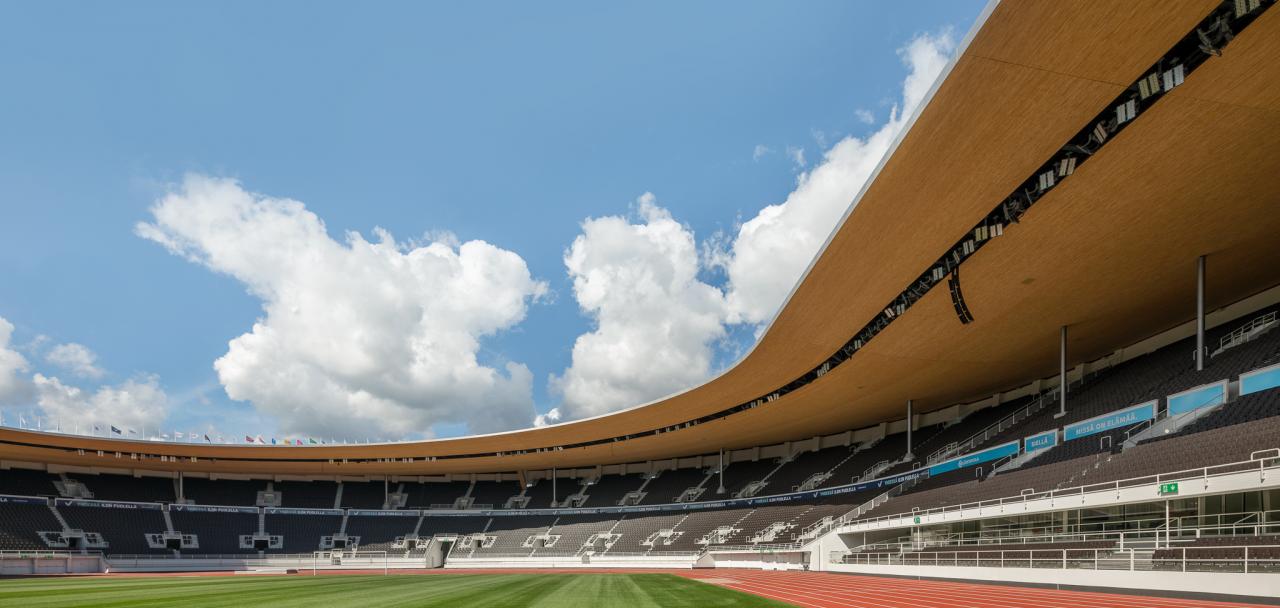THE OLYMPIC STADIUM - EXPERIENCES ON ENVIRONMENTAL TERMS
Sustainable development and environmental impacts were the leading principles of the Stadium’s refurbishment project from the drawing table to the everyday of the finalised arena. Every single choice at the Stadium from materials to energy use is well pondered, always with environmental aspects in mind.
The Helsinki Olympic Stadium is a multipurpose arena with much going on. Every day, the Stadium is the venue for the tenants in the facilities, the sports people and exercisers who train there, and also the numerous conference guests and tourists. During the events, the Stadium brims with tens of thousands of passionate fans, food, drink and joy. It is a large whole – and it is all but indifferent to us at the Stadium to make the correct material choices, energy efficiency and recycling decisions.
Sustainable choices underpinned by life cycle approach
When the Stadium was refurbish, we did not discard all that was old, on the contrary. Any decisions to reject materials were based on thorough analyses, and part of the old furniture was kept and treated to give them new splendour. Any new procurements were made in the spirit of life cycle thinking: the new elements of furniture are durable, Finnish quality products which match our aesthetics and the local climate. This allowed us to keep the procurement carbon footprint as small as possible, to trust the respect of labour conditions in production and to ensure design that was specially customised for this Stadium. Relying on Finnish competence and work was also a value choice.
In the choice of new materials, we paid attention to the entire life cycle of the products. The benches of the Stadium stand are made in Salo, Finland, using a composite material of recycled wood and plastic. The material includes a fire retardant that will last the whole life of the bench which reduces servicing needs. It is easy to change individual seats, and once their useful life ends, they can be safely disposed of as waste-to-energy.
Circular economy and small giant steps
The circular economy thinking is visible in every aspect of the Stadium life and almost on every surface. The rubber coating of the Stadium tracks includes recycled materials. The splendid grass has been grown in Finland, and it is maintained primarily with bio-fertilisers and mowed and aired with machines running on bio-diesel.
Waste recycling is another point of special attention. The Stadium’s underground waste management station has nine different waste fraction containers – even the bio-waste of the grass clippings is separately collected. Waste collection points are well visible in the public premises all over the Stadium.
The Stadium restaurant uses tableware and cutlery made of recyclable materials. It is equally important to keep the cycle alive: Stora Enso is going to start producing recyclable products from the fibre coming from the paper cups used at the Stadium.
Good energy not wasted
The grass heating solution, earlier based on electricity, is replaced by a district heating system which is more environmentally friendly. The Stadium field is divided into six different heating sectors with sensors for temperature and humidity. They allow us to know in real time when the sun provides enough heat for the sector in question, and then the heating can be turned off.
Good energy and its intelligent use have been in the focus in other areas, too. The Stadium utilises the Helen (Helsinki energy company) environmentally friendly energy solutions, be it power supply, charging of electric car batteries, heating or cooling. LED lamps ensure energy-efficient lighting, while the computer-guided illumination and heating allow for targeted consumption and rapid reacting. The electricity used comes from domestic hydro-energy sources with zero emissions.
The Stadium will gradually take over the zero-emission Helen Kiertolämpö (recycled heat) system. By combining Kiertolämpö and the power from renewable energy sources and district cooling, the energy consumption of the property entity can become fully emission-free.
Long life requires good care
Although designed to resist time, the Stadium – as any construction – also needs regular attention and care to have a long and good life.
Ilkka Rautakivi, Stadium Property and Safety Manager, underlines the importance of regular servicing and maintenance to reduce environmental impacts and extend the building’s life cycle. If a problem is found, action is taken now and not later.
Modern building systems include a lot of computerised and automated elements. If we do not know how to use the smart systems, we lose any benefits they offer. When competence is efficiently cascaded down among the personnel, the Stadium remains eco-savvy and a landmark under good care, to be proud of for a long time into the future.
The article is based on interviews with Ritva Määttänen, Sales Group Manager at Helen, as well as Ilkka Rautakivi, Stadium Property and Safety Manager and Marju Paju, Marketing and Communication Director.


























